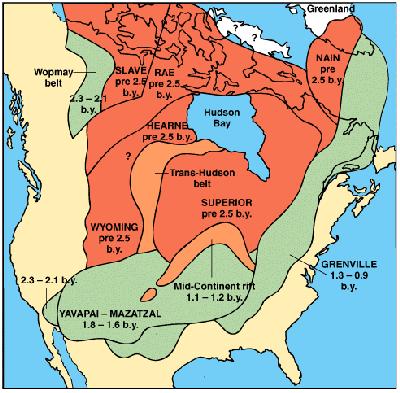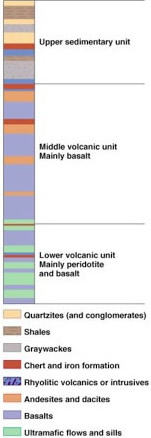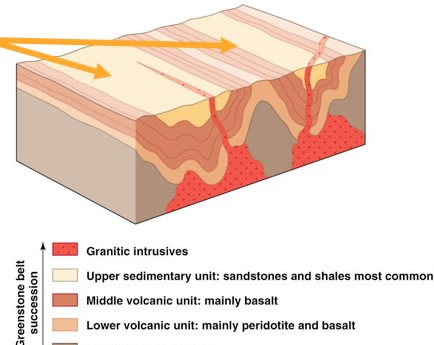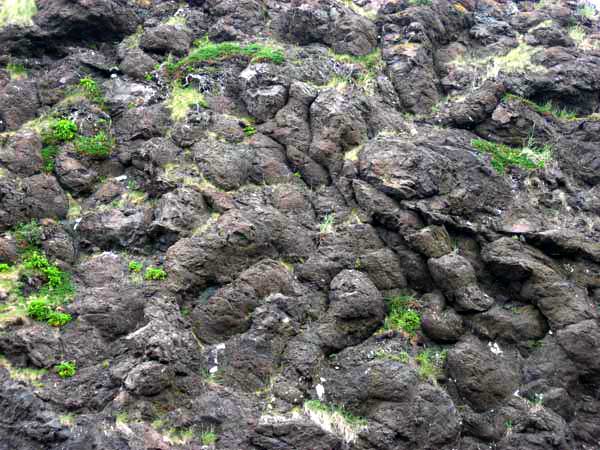The First Crust and the Development of Continents
As the early Earth began to cool the first rocks would have solidified on its surface. These rocks were most likely ultramaffic in composition due the greater amount of availble heat present on earth. As more magma rose to the surface the first thin crust would have been disrupted and numerous subduction zones would be formed around the planet. Just as today, subduction along these boundaries would eventually produce the first island arcs. As Earth continued to cool the process of subduction would produce magma increasingly richer in silica while the heavier elements such as iron and nickel would migrate towards the core. Eventually collisions between island arcs would form silica-rich materials that could not be subducted. Over time, these groups of merged islands arcs, or protocontinents, would grow by accretion along their margins and eventually the first continental nuclei or cratons would form.
Continents
 |
Map of North America showing cratons within the Canadian Shield |
We tend to think of continents as those areas of the Earth that are above sea level. It is important, however, to understand that some portion of a continent also continues below sea level. The true distinguishing feature of continents is that they consist of rocks with an overall composition similar to that of granite. Oceanic crust, on the other hand, is made up of basalt and gabbro. Due to its composition continental crust is much thicker and less dense than oceanic crust and, as a result, will not subduct. Because continents do not subduct the evidence of these rocks is not destroyed and the development of the first continents marks the begining of the Archean eon.
As alluded to in the previous section continents are composed of smaller land masses that have been welded together over time through the process of continental accretion. Precambrian shields are made up of areas where these most ancients rocks are exposed at the surface and can be found on all modern continents. As you continue outward from the shields the ancient rocks become buried under younger sediments in areas known as the platform. Together a shield and its platform make up a craton, which we are the ancient nucleai of continents. Cratons are the foundations of the continents, North America, for example, is composed of the Superior, Hearne, Rae, and Slave cratons, all of which were welded together along deformation belts to form a larger cratonic unit during the Proterozoic Eon. In North America, the exposed part of the craton is the Canadian shield. The Canadian shield can be found in most of northeastern Canada, parts Greenland, the Adirondack Mountains in upstate New York, and parts of Minnesota, Wisconsin, and Michigan.
 |
Typical profile of greenstone belt |
Although the Archean crust is made up of many different types of rocks the most abundant rocks occur in greenstone belts and granite-gneiss complexes. Granite-gneiss complexes are actually composed of a variety of rocks, with granitic gneiss and granitie plutonic rocks being the most common. These rock associations were probably the result of igneous activity within and around volcanic island arcs. Although they are much less abundant then granite-gneiss complexes, greenstone belts are incredibly important to unraveling some Archean tectonic events.
The typical greenstone belt has three main components; the lowest unit consists of ultramaffic volcanics such as basalt and peridotite, the middle unit is also volcanic but maffic in nature consisting mainly of basalt; the upper units are mostly sedimentary and consist of greywackes, shale and quartzites.
Greenstone belts typically have a synclinal structure and can measure anywhere from 40 to 250 km wide and 120 to 800 km long. Most have been intruded by granitic magma and cut by thrust faults. The green color of greenstone belts is caused by the presence of green minerals such as chlorite, actinolite, and epidote that formed during lowgrade metamorphism.
 |
Typical profile of a greenstone belt showing two adjacent greenstone belts |
The middle volcanic unit of greenstone belts also contain thick accumulations of pillow lava which indicates that much of the volcanism occurred below water. (indicating that water must have been present on the surface) The most interesting igneous rocks in greenstone belts are the komatiites that cooled from ultramafic lava flows and are found in the lower volcanic unit.
 |
Pillow lava, Newfoundland |
This type of igneous material requires near-surface magma temperatures of more than 1600°C. This is nearly 300° hotter than the the highest recorded surface temperature for recent lava flows (1350°C). This shows that during Earth's early history our planet possessed more radiogenic heat. As earth cooled these igneous rocks could no longer be produced and are therfore absent from the middle and upper layers of greenstone belts.
Sedimentary rocks are found throughout greenstone belts but are more dominant in the upper unit. Many of these rocks are successions of graywacke and argillite (slightly metamorphosed shale).
Evolution of Greenstone Belts
Both models for the origin of greenstone belts rely on plate tectonics. In one model greenstone belts develop in back-arc marginal basins that subsequently close as a result of the collisional processes involved with continental accretion. During subduction island arcs situated on the subducting plate are slowly drawn towards the non subducting plate and island arc. Once the oceanic plate is fully subducted the two island arcs collide closing the back-arc basin and producing the synclinal structure of greenstone belts.
